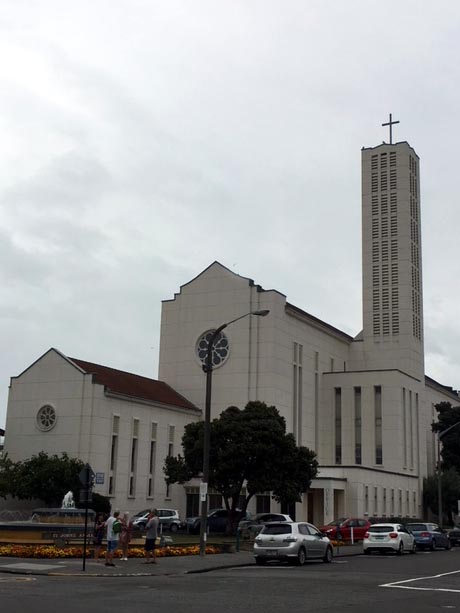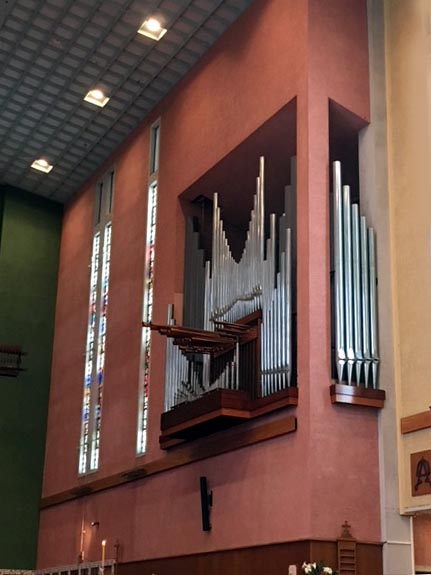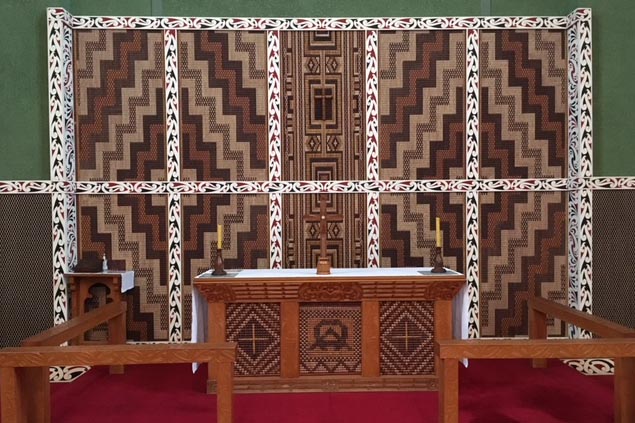| |
 |
 |
 |
| Comment on this report, or find other reports. |
 |
| Our Mystery Worshippers are volunteers who warm church pews for us around the world. If you'd like to become a Mystery Worshipper, start here. |
 |
| Find out how to reproduce this report in your church magazine or website. |
|
|
| 3278: Waiapu Anglican Cathedral, Napier, New Zealand |
 |
 |
 |
Mystery Worshipper: Scholastica.
The church: Cathedral of St John the Evangelist, Napier, New Zealand.
Denomination: Anglican Church in Aotearoa, New Zealand and Polynesia, Diocese of Waiapu.
The building: There has been a church on the site since 1862. The first permanent building, consecrated in 1886, was destroyed by an earthquake in February 1931 while communion was in progress. A massive upward thrust raised the cathedral into the air and it collapsed in ruins. A communicant member of the congregation was crushed by falling masonry and died there. The cathedral’s dean was also trapped by rubble that pinned down his ecclesiastical robes, but a brave woman in the congregation crawled over to him and cut him free with her nail scissors! For 25 years a temporary wooden building, dedicated in October 1932, served as a cathedral for the diocese. The present building, begun in 1955 and consecrated in October 1967, is in austere modernist style. In 1974 the altar was moved forward to a circular sanctuary from its original east wall position. The Maori Memorial Chapel was relocated to the previous sanctuary area, which is now surrounded by magnificent woven wall hangings and has an altar carved in Maori style. A display at the back of the church includes a cross made of silver nails, the gift of Coventry Cathedral in the UK, which was also destroyed and has risen again. The external bell tower appears to house a carillon; as we approached from several streets away, a series of hymn tunes was audible, as if summoning worshippers.
The church: Their website states that Waiapu Cathedral is the first cathedral to greet each new day, as it is the closest cathedral to the International Date Line. It serves a diocese of around 39,000 square kilometres of central and eastern North Island New Zealand. The name Waiapu means “abundant waters” and derives from a nearby river flowing down from Mt Hikurangi. “The people of St John’s Cathedral … aspire to be a people of faith, hope, and new beginnings” (cathedral website). There is a strong emphasis on community values. Worship is offered daily through services of morning prayer, mid-day prayer (Wednesdays) and a week-day eucharist (Tuesdays). The cathedral choir supports services on Sundays. A regular daytime Bible study group meets once a fortnight and the Association of Anglican Women meets monthly. The cathedral belongs to the Napier Inner City Churches group, with which it shares ecumenical events such as the forthcoming Lent focus on "Weaving Bonds of Belonging." It regularly offers a venue for concerts given by the Napier Civic Choir and Hawkes Bay Orchestra. In the week after our visit the cathedral planned to contribute to Napier’s annual Art Deco weekend, hosting the New Zealand Male Voice Choir on Saturday and, on Sunday evening, a "Swing and a Prayer service" with the Royal New Zealand Navy band.
The neighbourhood: Waiapu Cathedral is located centrally within the town of Napier, which was almost completely destroyed by the 1931 earthquake and subsequent devastating fire. The decision was taken then to sweep all the debris from the damaged buildings to the edge of the sea, where they now form the foundations of a wide, attractive promenade and seaside gardens. Napier was rebuilt in the fashionable architectural styles of the time, mostly Art Deco, and is therefore remarkably coherent architecturally. This choice was apparently pragmatic, as the designs are simple, easily built in concrete (a cheap material even during years of major recession), and being only one or two storeys high they are more likely to resist any future land tremors. Even today few buildings are taller. Napier has a busy seaport and is the largest wool centre in New Zealand. It exports wool, meat, apples, pears and stone fruit. It is also the centre of the Hawke’s Bay wine-growing region. Inevitably the concentration of Art Deco architecture has become a major tourist attraction and tourism is another important industry, reaching its peak annually in February with a four-day Art Deco festival.
The cast: Presiding priest and preacher: the Very Revd Ian Render, dean.
Priest assistant: the Revd Margaret Thompson.
Readers: Jonathan Krebs, Pam Medcalf.
Intercessions: Michael Morgan.
Director of Music: Anthony Tattersall.
The cathedral choir.
An unnamed assistant organist
The date & time: Sunday, 11 February 2018, 10.00am.
What was the name of the service?
Choral Eucharist.
How full was the building?
The building can seat several hundred people. There were perhaps 50 in the congregation. It seemed that comparatively few were expected, as all the pews in the rear half of the nave were roped off, presumably to encourage everyone attending to sit towards the front.
Did anyone welcome you personally?
The three women stewarding at the door welcomed us with warm smiles and greetings. One of them handed me a prayer book and a service booklet and asked where I came from. She obviously passed this information to the dean, whose opening welcome included mention of all the locations from which visitors had come.
Was your pew comfortable?
A firm wooden pew. Comfortable enough.
How would you describe the pre-service
atmosphere?
Quiet, with restrained organ music playing.
What were the exact opening words of the
service?
“Lord, for Thy tender mercy’s sake lay not our sins to our charge” (an anthem by the 16th century English composer Richard Farrant, sung by the choir as an introit from the back of the building).
What books did the congregation use during the
service?
All the words of the service except the hymns were in the New Zealand Prayer Book: He Karakia Mihinare o Aotearoa. Words for hymns and other parts of the service that the congregation had to say were in the service booklet handed out on arrival.
What musical instruments were played?
Organ – a handsome instrument with impressive trumpet stops facing across the choir pews.

Did anything distract you?
As I took my seat, I realised I could hear the hymns played on the carillon outside while the organ was playing in an entirely different key inside. Discordant to the point of painful! Fortunately the bells stopped before worship began.
Was the worship stiff-upper-lip, happy clappy, or
what?
Anglican choral eucharist, in English but with occasional sections in Maori (both are official languages of New Zealand).
Exactly how long was the sermon?
12 minutes.
On a scale of 1-10, how good was the preacher?
6 – The dean included a lot of interesting ideas in his sermon, and I sensed a deep commitment to valuing all people, but I felt as if I had arrived in the middle of a series of sermons around a theme and I wondered more than once if I was missing a seminal point of focus.
In a nutshell, what was the sermon
about?
He began by noting that a major news item of the week was that the Prime Minister of New Zealand, attending at Waitangi to celebrate Waitangi Day (Waitangi Day celebrates the Treaty between Maori and white settlers that created modern New Zealand), had elected not to have breakfast with "the great" of the land but to cook and eat breakfast with "the hoi polloi." Was not this the modern equivalent of "He hath filled the hungry with good things, and the rich he hath sent empty away?"
The theme thereafter seemed to be inclusion, though he did not use this word. He went on to quote various rather misogynistic texts from the New Testament, such as the warning that "wives should learn from their husbands," and he felt these sources could be a hindrance to a "salt and light community" seeking a 21st century theology centred on Christ. Such a patriarchal approach had to "sling its hook." What is needed is for all to come to Christ and to meet around his table as one community, for we are all invited.
Which part of the service was like being in
heaven?
The intonation of the creed by the assistant priest in Te Reo (the Maori language). She had a strong, confident contralto voice and the congregation responded with equal assurance. The warmth of the welcome also had heavenly quality.

And which part was like being in... er... the other place?
I could not join in with the opening hymn. It had the kind of tune that rambles around quite a lot. It was totally unfamiliar to me, and even the congregation did not seem to know it. Furthermore, even the choir processing in sounded hesitant. The only one singing confidently (and apparently from memory) was the dean!
What happened when you hung around after the service looking lost?
Drinks were served at the back of the cathedral afterward, and one cannot get out without being offered one. Several people said hello. Indeed, it was hard to make progress toward the coffee because of the need to respond to greetings. Over coffee more people engaged me in conversation, two explaining features of the building. I noticed also that the director of music stayed for coffee and a chat and seemed at ease with the congregation. Everyone was being so friendly, it looked as if they might be there all day.
How would you describe the after-service
coffee?
The coffee was instant but served hot. The tea was in a large pot with a knitted cosy.
How would you feel about making this church your regular (where 10 = ecstatic, 0 = terminal)?
8 – The welcome suggested it would be a good community to join. Friendliness appears to be deeply embedded in the culture of this congregation.
Did the service make you feel glad to be a
Christian?
Yes. I felt I was in company with a goodly host of Christians.
What one thing will you remember about all this in seven days' time?
The intoned creed and the warmth of the welcome. |
|
|
 |
 |
 |
| We rely on voluntary donations to stay online. If you're a regular visitor to Ship of Fools, please consider supporting us. |
 |
 |
 |
| The Mystery Pilgrim |
 |
| One of our most seasoned reporters makes the Camino pilgrimage to Santiago de Compostela in Spain. Read here. |
 |
 |
 |
| London churches |
 |
| Read reports from 70 London churches, visited by a small army of Mystery Worshippers on one single Sunday. Read here. |
| |
|
|
|
|


